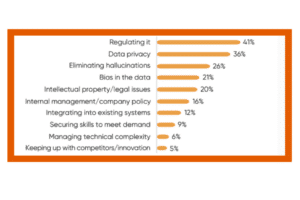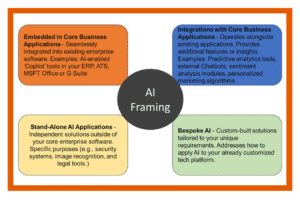AI is such a hot topic and today, I’m exploring the impact of AI on recruiting. First, as a reminder, my team at Elevation Talent Group has two practice areas: human resources and marketing. We are experts in recruiting and hiring in both spaces. We know how to listen to the needs of hiring managers and the problems they are trying to solve. We put these skills to the test every day when we talk to hiring managers about their open jobs and then match, screen, and choose candidates to present back to those hiring managers. Put even more bluntly, we earn our living in this trade and we take AI very seriously.
Will AI Render Recruiting Obsolete?
What do we think when people say AI is going to take-over recruiting? We pay attention and prepare for change! Our tenured team has seen many seismic shifts in our industry and AI is the next shift, for certain.
Digging deeper, we’ve asked ourselves, ‘what will be AI’s impact on recruiting?’ This excellent article 2024 Talent Acquisition Trends Led by GenAI, Skills-Based Hiring (shrm.org) starts to answer this question with these important ideas:
- GenAI will generate job descriptions and job ads, draft candidate outreach, identify passive candidates, engage with candidates through chatbots, suggest interview questions, make recommendations for job ad placement, and compose offer letters.
- AI will assess candidates to predict the best matches for roles. Recruitment chatbots will answer candidates’ questions in real time. AI will save money and time.
- “There’s no escaping the magnitude of the impact of generative AI,” said Kevin Oakes, CEO of the Institute for Corporate Productivity (i4cp), a human capital research firm in Seattle.
The key lesson (for all of us, marketers and HR professionals alike) is that when a technology saves money and time at scale without a decrease in quality, the tech will be implemented.
Are the savings real? Yes, they are. Several years ago, a study in the Asian employment markets pointed to cost of hire savings up to 75% and time-to-fill improvements of 80%. With savings at even half of those rates, many managers will race to AI deployments.
So, is the runway clear for AI deployment in recruiting? The short answer is NO (or at least it should be!). We need to account for the important caveat above when I said, ‘when a tech saves money and time at scale without a decrease in quality, the tech will be implemented.’ In the case of recruiting and hiring, quality includes controlling bias in automated decision making. The examples of firms and governments confronting AI’s lack of fairness are well documented:
- LinkedIn’s job-matching AI was biased. The company’s solution? More AI. | MIT Technology Review
- AI-assisted recruitment is biased. Here’s how to make it more fair. | World Economic Forum (weforum.org)
- Diversity, inclusion, and Responsible AI are now the bedrock of bias prevention
- Wired’s story about Rotterdam’s welfare fraud detection model is an excellent example of the controversy about predictive analytics. When I read the Wired story, I recalled Spielberg’s movie, Minority Report. Tom Cruise thought the AI was trustworthy. Not quite. Lots to think about.
Navigating AI in Talent Acquisition: What Recruiters and Hiring Managers Must Know for Success
As a technology exec and consultant in the staffing/HR business, I see many AI solutions in the market. You can’t pick up a business periodical without having at least one article in it being associated with AI. You may be deleting those articles from your news feed or multitasking when somebody starts talking about AI, but there are three AI takeaways I’d like to share with you.
- Get orientated to some of the details of AI today. Using AI is not like being Neo in the Matrix where you’re given a choice between the red or blue pill. Sampling and learning what works for you and your team is the right path.With just a handful of examples you will find yourself being reoriented to the possibilities of this technology. I suggest trying Microsoft’s Copilot in the Bing browser and Perplexity. I really liked this Salesforce AI video and this short Microsoft demo. Want to see recruiting AI? Check out Sense or Staffing Engine.
- Know the AI problem issues. If you are advocating for AI or want to learn more, read this short piece from Gartner. Generative AI: What Is It, Tools, Models, Applications and Use Cases (gartner.com) Garner surveyed business execs and ranked these AI issues. You’ll want to at least have thought about these:
- Know that AI will take many forms and be deployed in different ways. Two distinctions are important:
- AI Forms: Getting a handle on the difference between the generative AI models (think ChatGPT) vs. the machine learning/predictive models (think matching algorithms). Each form of AI has specific use cases and each has their own problems.
- AI Framing: the picture below was helpful to me. I think about this framework for staffing and HR frequently. If you are serious about talking about AI in your business, use this framing. The best AI solution for most firms will be some combination of these architectures.
For many technologists, AI is the most important development since the internet. I agree with them. We know how the internet changed the world! AI’s journey has just begun.




